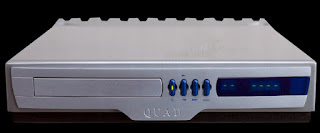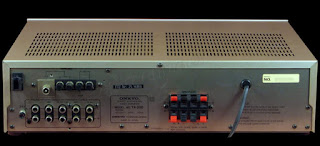The Quad 99 CD-P is
a versatile CD player with several advanced features. The CD-P will play
regular music CDs, music and standard CD-Rs (open or closed) and CD-RWs.
Automatic upsampling increases the detail levels in your CD collection, and the
ability to add three digital and three optical sources enables you to get the
very best from your other digital media. An optical output is provided to
connect the CD-P to other digital equipment.
The CD-P accepts
three optical and three digital inputs. Minidisc and DAT players, or Digital
Audio Broadcast tuners (DAB) will be significantly improved by connecting their
digital outputs to the CD-P. The CD-P can accept incoming PCM digital signals
to a maximum resolution of 24bit/96kHz.
The Quad CDP-2
mechanism was a major engineering project. Whereas most manufacturers use
off-the-shelf transports, we wanted a unit which was particularly optimized to
static CD players and employed a ‘lazy servo’ mechanism. In all off-the-shelf
CD mechanisms – even those used by high-end manufacturers, there are a number
of compromises built into the device which mean that they can be used for a
number of applications. With a new Quad mechanism, it could be safely assumed
that the CD player would be sat on a farily rigid structure and vibration,
whilst possible would be limited.
This enabled us to
develop a proprietary ‘lazy servo’ mechanism, which involves the way the
transport deals with disc data loss. Where most transports, upon loosing a data
stream, move the optic (laser) back a forward rapidly to recover the lost data
– ours just sits there and waits for the disc to come around. This has a
significant benefit in lowering the noise floor of the player. Some innovative
timing techniques used, also result in an industry leading jitter measurement
of just 8 pS. These technical innovations combined with its versatility of use
(particularly the 6 digital inputs and adjustable level output) make the CDP-2
one of the finest CD players on the market today at any price.
Max. Line Output Level (RCA): 2,4 V RMS
Max. Output Level
(Quadlink): 5,3 V RMS (Balanced)
Frequency
Response: 20 Hz - 20 kHz (+0 dB -0,5 dB)
Total Harmonic
Distortion: less than 0,002% (at 1 kHz)
Signal-to-Noise
Ratio: better than 110 dB at 24 bit (20
Hz - 20 kHz)
Better than 95 dB at
16 bit (20 Hz - 20 kHz}
Crosstalk: less than -100 dB (at 1 kHz)
Gain Error: less than 0,5 dB (at -90 dB, f=500 Hz)
D/A Converter
Max. Resolution
: 24 bit
Max. Samplig
Frequency : 192 kHz
Upsampling: x2
Digital Audio
Inputs:
3 x RCA Coax 75 Ω
,SPDIF
3 x optical Toslink,
SPDIF
Digital Audio
Output: Optical Toslink SPDIF
Disc
Compatibility: CD-DA Conventional Audio
CD, CD-R Recordable CD
Dimensions (W x H x
D): 80 x 321 x 310 mm
Weight: 4,5 kg

























